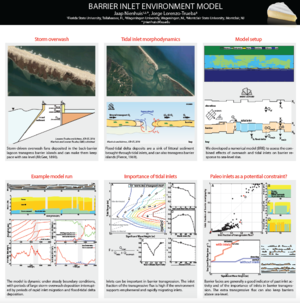2018 CSDMS meeting-015
Log in (or create account for non-CSDMS members)
Forgot username? Search or email:CSDMSweb@colorado.edu
Browse abstracts
Can barrier islands survive sea level rise? Tidal inlets versus storm overwash

Barrier island response to sea level rise depends on their ability to transgress and move sediment to the back barrier, either through flood-tidal delta deposition, or via storm overwash. Our understanding of these processes over decadal to centennial time scales, however, is limited and poorly constrained.
We have developed a new barrier inlet environment (BRIE) model to better understand the interplay between tidal dynamics, overwash fluxes, and sea-level rise on barrier evolution. The BRIE model combines existing overwash and shoreface formulations with alongshore sediment transport, inlet stability, inlet migration and flood-tidal delta deposition. Within BRIE, inlets can open, close, migrate, merge with other inlets, and build flood-tidal delta deposits. The model accounts for feedbacks between overwash and inlets through their mutual dependence on barrier geometry.
Model results suggest that when flood-tidal delta deposition is sufficiently large, barriers require less storm overwash to transgress and aggrade during sea level rise. In particular in micro-tidal environments with asymmetric wave climates and high alongshore sediment transport, tidal inlets are effective in depositing flood-tidal deltas and constitute the majority of the transgressive sediment flux. Additionally, we show that artificial inlet stabilization (via jetty construction or maintenance dredging) can make barrier islands more vulnerable to sea level rise.
Play
| Barrier Inlet Environment model, showing landward movement of a barrier and its tidal inlets in response to SLR. Landward movement is due to overwash fluxes and flood-tidal delta deposition. |
